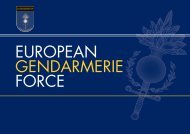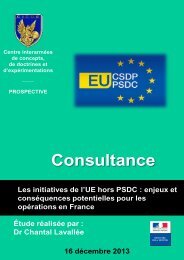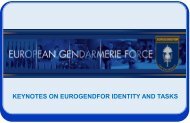Conference
science-research-bulletin-2013-conference
science-research-bulletin-2013-conference
You also want an ePaper? Increase the reach of your titles
YUMPU automatically turns print PDFs into web optimized ePapers that Google loves.
EUROPEAN POLICE SCIENCE AND RESEARCH BULLETIN<br />
SPECIAL CONFERENCE EDITION<br />
a ‘sub-Bronze’ commander of Inspector level.<br />
In addition to each having experience of public<br />
order leadership, the PLT Bronze, two sub-<br />
Bronzes and Negotiator Co-ordinator were all<br />
highly trained ‘crisis negotiators’.<br />
The lower ranks of the PLT were made up of<br />
hand-picked individuals who were already<br />
highly regarded (e.g. due to their work<br />
on Safer Neighbourhood Teams) for their<br />
communication skills and capacity to engage<br />
with the general public: ‘The type of individuals<br />
who, they already knew, were not quick on the<br />
draw, and who could handle people with some<br />
patience while keeping up a pleasant smile’<br />
(Interview, PLT Sub-bronze). Steps were taken<br />
to ensure that the public was able to see the PLT<br />
as visibly and qualitatively ‘different’ from the<br />
other police present:<br />
‘In the old days of public order, the police were<br />
the forbidding black line, but now people see<br />
fluorescent jackets and it’s ‘Look out, here come the<br />
police!’ So, we deliberately went for something very<br />
different. We went for blue tabards with ‘Liaison<br />
Officer’ on them, which deliberately kept us very<br />
separate from the other officers’. (Interview, PLT<br />
Sub-bronze)<br />
This general commitment to a softer,<br />
communications-based approach to protest<br />
policing was exemplified by the attitudes<br />
of two strategically important commanding<br />
officers, the PLT Bronze and the Public Order<br />
Bronze commander with overall responsibility<br />
for deploying PSUs at the actual protest<br />
venue. The former had followed Silver’s<br />
recommendation by attending a one-day<br />
professional development course at Liverpool<br />
University, where participants were addressed<br />
by a specialist in Swedish Dialogue Policing<br />
methods and a principal legal adviser to the<br />
HMCIC ‘Adapting to Protest’ inquiry:<br />
‘To be honest, one of the things that stick in my<br />
mind is that there was a Chief Superintendent from<br />
somewhere or other who asked a question along<br />
the lines of: “Aren’t we bending over backwards for<br />
the protest groups?" And [the legal adviser] gave<br />
him a great answer that will always stick in my<br />
mind. She said to him, "Your job is to uphold the<br />
law, and the Human Rights Act is the law. That’s<br />
your job and you can’t pick and choose which bits<br />
of the law you like.” And I must say that I came<br />
away and built our briefings and tactics around<br />
that statement’. (Interview, PLT Bronze)<br />
His Bronze public order counterpart explained<br />
in interview how it was the political conviction<br />
resulting from a family background of trade union<br />
support and the insight provided by subsequent<br />
university education which enabled him also to<br />
‘buy into’ this softer policing style. Previously,<br />
he reckoned, the ‘British model of policing’ had<br />
been unfairly designed to serve the rich, and<br />
he therefore welcomed the progression to a<br />
more universal appreciation of people’s rights:<br />
‘These rights are there for all of us to enjoy and,<br />
in the past, I don’t think we’ve been sufficiently<br />
conscious of that. So, yes, I do buy into it’.<br />
PRE-EVENT LIAISON<br />
During pre-event planning for Operation Obelisk,<br />
the Silver Commander stated a preference for the<br />
march to follow a clearly prescribed route, which<br />
(for safety reasons) would involve protesters<br />
departing from tradition by not bearing down on<br />
the City Hall via Devonshire Street, and taking a<br />
more circuitous route via the lower end of town.<br />
Pre-event liaison with organisers was therefore<br />
geared to using standard sets of negotiating<br />
skills a la the Metropolitan police commanders<br />
observed by PAJ Waddington twenty years<br />
earlier. Such repertoires would be used, not only<br />
to gain the demonstrators’ compliance with<br />
the preferred route, but also to optimise police<br />
intelligence and thereby ensure that there would<br />
be ‘no surprises’ from any party’s perspective on<br />
the day.<br />
‘We have these things called “bunches of fives” in<br />
negotiator terms, which are basically reasons to do<br />
something. If you’re negotiating with someone over<br />
the phone or face-to-face, it’s always good practice<br />
to have these bunches of fives: five reasons not to<br />
kill yourself; five reasons to go this way down the<br />
street; five reasons to let hostages go, and so on. We<br />
also have something else called PPAs — “Positive<br />
Police Actions” — where it’s a kind of reciprocity<br />
thing, really: “This is what we’ve done for you.<br />
What can you do for us?” So, we were looking round<br />
in terms of, ‘What can we bring from negotiating,<br />
from crisis and hostage intervention, into dealing<br />
with people who aren’t overtly hostile, but who are<br />
not anticipating police in their midst. It was a case<br />
of: “How can we sell what we want to happen on<br />
that day, rather than enforcing it?” So, we’d got<br />
rehearsed bunches of fives as to why they should<br />
take that route’. (Interview, PLT Sub-bronze)<br />
36





